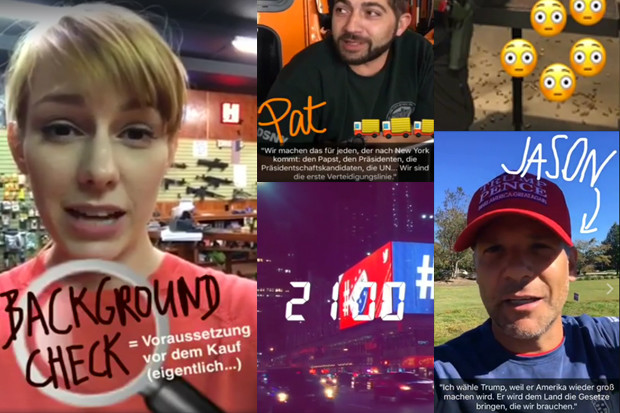The German national broadcasters, ARD and ZDF, have developed a news channel on Snapchat to reach younger audiences with their coverage of news and current affairs.
Hochkant, meaning 'vertical', is part of a bigger initiative called Funk, which sees the country's TV and radio stations use new formats to approach audiences under the age of 30, who have been switching off from linear news bulletins.
"The stations decided to go where the audience already is," explained Eva Schulz, a reporter at Hochkant.
"Teenagers don't watch news on TV, and if they did, it would be some strange, old, anchorman in a suit, who broadcasts the news in a way that is not appealing to them. But news through Snapchat is exciting."
The project, which started on 1 October, is primarily co-ordinated and funded by regional Berlin broadcaster RBB, part of ARD. It is produced by a small editorial team in Berlin and three journalists abroad who work together to develop the format of the channel and the topics covered.
"We use a WhatsApp group to co-ordinate plans, discuss what is the most relevant topic for our target group for the day, and how we should cover it," she said.
"We don't have a fixed schedule, as we all cover different topics such as politics, entertainment and lifestyle, so we try to get the right person to cover the story in their patch, but of course that is not always possible."
Between 6am and 9am, the journalists use pictures to produce a morning news summary of the five most important news events in the last 24 hours, but the rest of the day is played off the cuff, depending on what the headlines of the day are.
If nothing happens, we are not going to post nonsense. It's not linear, so we don't have a fixed schedule, but are there if there is a story to tellEva Schulz
"If nothing happens, we are not going to post nonsense. It's not linear, so we don't have a fixed schedule, but are there if there is a story to tell," she said.
"We have to find ways to tell stories in interesting ways through Snapchat, where our audience can identify with what they are watching.
"At the moment, we are having a lot of organic growth which is nice, but we're thinking about how we can reach a broader audience to find more followers."
Schulz found that when travelling around America, audiences were following her journey as she attending election events and interviewed members of the electorate.
"We don't have the statistics as to where people are watching, how old they are, or whether they are male or female. But we get a lot of teenagers that snap us back and say they think it is cool that this is for their age group – they seem to really appreciate it," she said.
"They also send a ton of questions to us. After the election, I had many asking about their concerns and worries from the result, so I spent the entire day answering them all.
"It was exactly our intention to be approachable and close to youngsters who need the story to be explained in a different way."
Among some of the challenges the team has faced over the last eight weeks is the fact that only one person can be logged into the account at any one time.
"When I was in the US and we had a six-hour time difference, my team had to call to tell me to sign out of the channel so they could do the news. Otherwise they would have had to kick me out without any warning," Schulz said.
"You really have to deal with the Snapchat limitations, but in some ways, that makes you really creative and organised – we are all just intrinsically motivated and we are making it work."
Schulz advised publishers looking to get started using Snapchat to motivate their staff to try it out on their own first to get acquainted with the platform, and even to get interns, who are likely to use the platform in their own time, to think of new ways in which it could be used.
"I've heard so many people complain that they aren't a fan of Snapchat because they have to tell chronological stories, in vertical video, without any room for vanity, but it's such a big opportunity to play and become creative and try things out," she said.
"Don't just do it because you feel you have to, that's not going to lead to innovative content. Think of the specific audience who uses Snapchat.
"News organisations need to be there when older and bigger audiences are interested in consuming these animated vertical videos, even on platforms other than Snapchat."
Free daily newsletter
If you like our news and feature articles, you can sign up to receive our free daily (Mon-Fri) email newsletter (mobile friendly).
Related articles
- Journalists are happy to be disconnecting from platforms, should news organisations be worried?
- Protecting journalists on social media, with Valérie Bélair-Gagnon
- What will your audience want in the future?
- 15 free sources of data on the media industry
- New European journalism database facilitates cross-border collaboration










